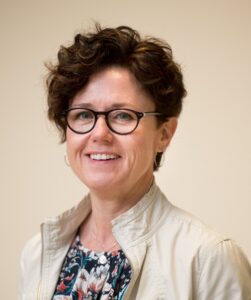Pace, Plan, and Prioritize: One Woman’s Story on Coping with Long Covid

Subscribe to Catalyst
Subscribe to get our magazine delivered right to your inbox
Related Articles
Subscribe to Catalyst
Subscribe to get our magazine delivered right to your inbox
Related Articles
Since there’s no cure, those affected must work to manage their symptoms. An innovative hospital program takes an interdisciplinary approach encompassing physical, cognitive, and psychosocial care.
When Lisa Evans gets up each day, she’s faced with a tough choice: shower or wet wipes.
It’s a decision she never dreamed she’d be making a year and a half ago, when she was full of energy, exercising several hours a week with ease.
More than a year into her battle with post-COVID-19 condition, also known as long COVID, Evans is grateful if she can walk more than a few blocks. It’s just one of the many changes that have made her life feel surreal.
In fact, Lisa Evans isn’t even her real name. She requested anonymity because she fears discrimination by her employer and judgment from her peers.
“This is the height of vulnerability,” she says. “Every day I’m scared of something. Will my symptoms get worse? Will I need a caregiver? Will I be able to breathe? I can’t afford to worry about negative perceptions about my work on top of it.”
For me, her precaution needs no explanation. When my own COVID-19 symptoms lingered several months longer than news coverage led me to expect, I dreaded every question about my progress from well-meaning colleagues. I relied on tried-and-true responses like, “still not quite 100 per cent,” when what I wanted to say was, “Every work day feels like a marathon I didn’t train for.”
While my own symptoms subsided half a year later, Evans continues to suffer from debilitating fatigue, dizziness, headaches, irregular heartbeat, and disturbances of taste and smell. With her once favourite foods having lost all appeal (tomatoes now taste like “rotten socks”) and cooking becoming a Herculean task, she has also lost nine kilos.
We are far from alone in these experiences. Initially, the World Health Organization estimated that between 10 and 20 per cent of people who were infected by the virus experienced a post-COVID condition — defined as “the continuation or development of new symptoms 3 months after the initial SARS-CoV-2 infection, with these symptoms lasting for at least 2 months with no other explanation.” Updated research suggests that 30 to 40 per cent of people who have caught COVID still report symptoms beyond three months of their initial infection, with new data changing these numbers all the time.
Beyond the statistics
Few people can put faces to the figures quite like Wendy Laframboise, a nurse practitioner who coordinates the post-COVID rehab program at The Ottawa Hospital. With 287 referrals and more than 400 sufferers and caregivers reaching out for support (so far), Laframboise is intimately aware of the realities of long COVID.
“Most of our patients are not the people you’d expect to have lasting symptoms,” she explains. “These were very high-functioning, athletic, successful people with little if any previous medical history. Now, almost all have had to put their jobs — and their lives — on hold.” For the few who remain employed, she tells me, the decrease in functionality often means an increase in stress and anxiety around work.

The Ottawa Hospital
Since there’s no cure for long COVID, the program aims to help patients manage their symptoms and improve their quality of life across three domains: physical, cognitive, and psychosocial. The model is based on the hospital’s chronic pain program and draws on research from the rehabilitation unit’s work with traumatic brain injuries and chronic respiratory diseases.
Over four weeks, patients work with a nurse practitioner, a respiratory therapist, an occupational therapist, a physiotherapist, a dietician, and a psychologist in highly interactive, virtual sessions. Through education, discussions, and goal-setting workshops, they learn to cope with symptoms like breathlessness, stress, and poor concentration (often referred to by long-COVID patients as “brain fog”).
The results so far have been overwhelmingly positive, with patients showing improvements across all three domains, both at the end of the program and at the three-month followup stage. For some, improvement means breathing more efficiently. For others, it’s the difference between playing with their child and being confined to bed.
Laframboise credits the interdisciplinary team with much of the program’s success, which includes the active involvement of a rehabilitation psychologist.
“Long COVID takes a significant mental toll on everyone,” she says, noting that depression and anxiety often appear for the first time or get worse in those who already have it. “The most common feeling patients express is a loss of their previous self. There’s lot of frustration and guilt about what they’re no longer able to do — in their relationships, for their kids, and for themselves.”
Laframboise adds that there’s a very real stigma associated with invisible illnesses, especially one as new as long COVID. “People can’t believe it’s possible to go from 100 per cent to 10 per cent. But it is.”
To complicate matters further, she tells me, there’s no clear healing trajectory. Unlike a broken leg with established healing milestones each week, long COVID is neither linear nor consistent. One week someone might have a headache and dizziness; the next it could be ringing in the ears and shortness of breath.
Misunderstood — and missing out
Evans is all too familiar with the roller coaster of symptoms, and the isolation that comes with it. “I spent the whole summer on the couch. All I wanted was to be outside in the sunshine, but my body wouldn’t allow it.”
While physical limitations continue to keep her isolated from the world beyond her apartment, it’s the lack of understanding that isolates her from her friends and family.
“People in my life have suggested that I try just getting a little more sleep,” she says, adding that friends have grown impatient with her absenteeism and cancelled video calls. “There’s not enough sleep in the world that could fix this.”
In search of some common ground, Evans joined a Facebook group for so-called COVID long haulers in Canada. The group is private, and only those with long COVID and their families are permitted to join. At this point, it has more than 18,000 members.
“There are new posts every day about experiences like mine,” Evans tells me. “Some people are into their third year with these symptoms and have run out of hope. No one else understands what it’s like.”
In working with the post-COVID rehab program, Laframboise has been surprised most by two things: the impairment wrought by the condition and the power of validation.
Even before starting the program, patients on the wait list are assured that what they’re experiencing is legitimate and, despite how it may feel, they are not alone. The program also leaves plenty of room for open discussion, both in group and one-on-one sessions with experienced clinicians. Giving patients these opportunities to share their experiences without judgment is more beneficial than Laframboise could have imagined.
“Once patients feel validated in their experiences, it’s easier for them to focus on techniques to cope with what’s happening,” she says, explaining that everyone is taught to “pace, plan, and prioritize” their daily actions within the confines of severe fatigue — the most pervasive of long COVID symptoms.

Wendy Laframboise, Nurse Practitioner
Pacing, planning, and prioritizing are concepts Evans has had to learn on her own, and she credits them with her ability to keep working. “I’ve learned to perform a cost-benefit analysis for my day, calculating exactly how I’m going to use my energy,” she says. “I have to choose if I’m going to work, cook dinner, or do laundry because there’s only energy for one.”
Rethinking productivity — and everything else
Evans’s other takeaway from her experience has been somewhat harder to process. She’s learned that, in many ways, society isn’t made for people with disabilities. Necessities like groceries cost more when you always have to pay for delivery. Likewise, the mobility scooter that could give her added freedom would mean paying for an extra parking space in her building, or else heaving it over the threshold of her front door.
But Evans has realized that ableism goes much deeper than our pocketbooks. “We’re programmed to put productivity above everything,” she says. “We ask, What did you do today? instead of, What did you think today? What did you feel today? Maybe those are the questions we should be asking each other.”
Hearing this, I can’t help but think of recent headlines touting new research that says most long COVID symptoms should resolve themselves in a year. My own post-COVID symptoms lasted six months, and the thought of doubling it leaves a knot in my stomach. A year of missed opportunities and unmet goals. A year of choosing rest over writing. A year of tuning out conversations and in to my own breathing. A year of foggy milestones — two full holidays I barely remember. I learned that being semi-present is a lot like not being there at all.
As for Laframboise, she is grateful for the relief The Ottawa Hospital program has brought to so many, but she knows it’s not enough to meet the need. “I want the word to get out about this for people like my patients. They need more programs to help them get their lives back, and they need them now.”
Evans agrees that there is much to be done to support people like her, with research, resources, and understanding all sorely lacking. Still, she isn’t giving up hope. “I’m determined not to let another summer pass me by,” she says. “Even if it takes all of my energy, I’m going to feel the sunshine on my face.”
Resources:
The Ottawa Hospital’s post-COVID self-management program
COVID-19 Resources Canada




